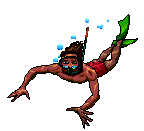 Teacher's Guide
Teacher's Guide
Water Cycle
Overview:
During this introductory lesson, students will be introduced to the Water
Cycle. If you have already covered the water cycle, you may choose to omit
this lesson and skip onto the next lesson, The
San Francisco Bay.
Background Information:
The Earth is a dynamic system, spinning on its axis as it revolves around
the Sun. The surface of the Earth includes the atmosphere (the air
surrounding the Earth), the hydrosphere (the water on the planet), and
the lithosphere (the land that makes up the Earth). The interaction of
these spheres creates the life sustaining Water
Cycle.
Where did water come from?
The oceans were created over eons of time by hydrogen and oxygen that united
inside the earth to form water which was then trapped in the Earth. Volcanic
events over a long span of time "out gassed" much of this water in the
form of steam. The steam formed clouds in the atmosphere, and precipitation
brought the water back to Earth, to continue the endless water cycle. The
miracle of water then created conditions for life to develop and survive
on this planet.
The Water Cycle
The water cycle is a major driving force on our planet. Water is in constant
motion, evaporating into the atmosphere to later fall in the form of precipitation
to form oceans, lakes, rivers, and streams. Water
is not consumed, but is continuously recycled.
When water is heated, it changes from a liquid to a gas. This process
is called evaporation. As the water vapor moves higher into the atmosphere,
it cools. This cooling of water vapor results in condensation of the vapor
into liquid. We can see water vapor condensing when we watch clouds. A
cloud is nothing more than water vapor that has condensed back to a liquid
form. A cloud is made of extremely tiny drops of water which can remain
in the air. As a cloud grows, and more and more water condenses in the
same place, the cloud droplets get larger. Eventually, these cloud droplets
will be too large to remain in the air. The cloud is then said to be saturated.
A saturated cloud will usually precipitate, or let fall, its excess water.
Precipitation takes the form of rain, snow, sleet, or hail. The water flows
on the surface of the ground and percolates through the Earth as groundwater.
Eventually this water makes its way back to the rivers, streams, and oceans
of the world where it is once again evaporated into the clouds, continuing
the water cycle.
Pollution and the Water Cycle
Water is an important commodity to all organisms that live on Earth. Although
it appears as if we will never run out of water, only 3% of all Earth's
water is fresh. Of this 3%, 2/3 is locked up as ice and is therefore unusable.
This means that only 1% of all the water on this planet is available for
us to use. 97% of all the water on this planet is salt water which is unusable
by most land organisms. The ocean water was formed as fresh water eroded
the land and dissolved different salts that remain in the water. The oceans
play important roles in the water cycle because they contain so much of
our available water. Unfortunately we cannot use the ocean water as it
is. Instead we must wait for it to be evaporated, leaving behind salt and
other impurities, and then fall back to the Earth as precipitation.
Since only pure water evaporates, pollution will also be left behind
in the ocean during evaporation. Even though this pollution does not enter
our water cycle, it is still present in the waters of streams, rivers,
and oceans. For this reason, we must be concerned with what we put into
the water systems.
Student Activity:
-
Make an overhead copy of this worksheet, to use while you present the background
information.
-
Trace out the path (on the overhead) of water as it travels through the
water cycle.
-
Explain the importance of the water cycle in cleaning up our water supply.
Be sure to explain that only pure water evaporates, leaving behind pollutants.
-
Print out a copy of the Water Cycle Worksheet for each student.
-
Review the directions with the students as they complete the worksheet.
-
If you choose to collect the worksheets, be sure to return them to the
students for review.
4-6 Watershed Curriculum Next Lesson
 Teacher's Guide
Teacher's Guide